Cover Story Sidebar
Cornell's academic heart: Spotlights of recently hired faculty
Esra Akcan: History-surveying architect
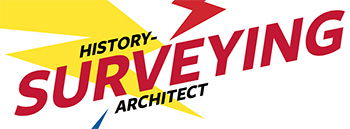
At the center of associate professor of architecture Esra Akcan's teaching and research are a geopolitically conscious global history of architecture, the exploration of cosmopolitan ethics and global justice.
In her scholarly work, Akcan offers new ways to understand the global movement of architecture in two books she authored on architecture in Germany and Turkey, both published in 2012. "Architecture in Translation: Germany, Turkey and the Modern House" highlights the historical, albeit uneven, translations between places by analyzing the transformation of people, ideas, technologies, information, objects and images as they were transported from one location to another. The book also advocates for a commitment to a new "culture of translatability" from below and in multiple directions, defined by Akcan as openness to translations from around the world rather than from one center, and with a purview of global justice rather than an imperial imagination.

Associate professor of architecture Esra Akcan. See larger image
"Turkey: Modern Architectures in History," penned with co-author Sibel Bozdoğan, is part of a series that aims at an inclusive survey of modern world architecture; it's the first volume in any language to cover the entire 20th century in Turkey.
Akcan prepares the students in her History of Architecture survey course (for all incoming undergraduate and graduate architecture students) for globalization, as well as ethnic and gender diversity, through the concept of "intertwined history," the migration of people and translation of cultural artifacts. The course continues to evolve as scholarship in this area grows.
"My contribution in teaching this course is to prepare the students for global practice by introducing them to a vision of modern architecture that includes but goes beyond the canon, but also one that does not divide the world into set self-contained geographical zones (such as European, Asian, African architecture), by showing the interactions between places."
The city of Berlin has been a particular focus of study for Akcan. She received the 2016-17 Berlin Prize from the American Academy in Berlin, where she holds a fellowship to write her next book on the urban renewal of Berlin's immigrant neighborhood, through which she explores a theory of open architecture. Her research has fostered in her graduate students a compassionate and critical investigation into the migrant crisis there and elsewhere in Europe. For example, Jordan Berta, M.Arch. '16, credited Akcan, his professor and thesis adviser, for inspiring and supporting his investigation into the social implications of asylum and immigration.
Educated as an architect in Turkey and holding a Ph.D. from Columbia University, Akcan came to Cornell in 2014. Along with numerous awards, fellowships and published articles in multiple languages, Akcan carries her research and ideas about contemporary cities into multimedia art projects, using fiction, photo-collage and video installations.
– Patti Witten
Christopher Alabi: Nano-slicing engineer
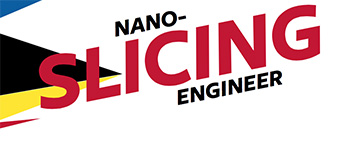
Nanoparticles engineered to usher life-saving medicine through the human body often don't reach their targets while navigating such a complex environment. Christopher Alabi, assistant professor of chemical and biomolecular engineering, is changing the way drug delivery systems work and advancing the emerging field of nanoparticle therapeutics.
"I am making polymers that look like the biopolymers in our bodies, but are instead created with synthetic molecules designed in our lab," Alabi says. Biopolymers include the proteins, DNA and RNA found in all living organisms. "We want to use what the body already makes as a guide, but then improve upon it by adding one modification at a time in a very controlled process," he explains. "This level of control is important, especially when these bio-active polymers are used as scaffolds to carry drugs exactly where we need them to go."
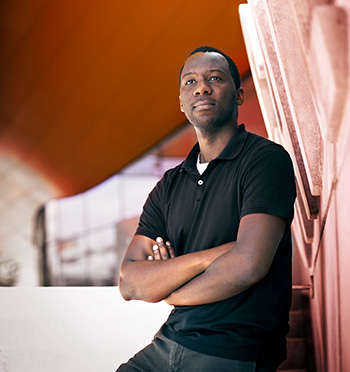
Christopher Alabi, assistant professor of chemical and biomolecular engineering. See larger image
A second line of research in Alabi's lab involves understanding the underlying principles that dictate how nanoparticles move and interact in biological environments. For a targeted treatment to work, the active compounds need to get into specific compartments in the cells where they can be the most effective. The targeted treatment must be able to sense, respond and adapt to the local environmental cues to reach the desired site of action.
"In the end, any process we come up with must be scalable for it to have any real impact," says Alabi. "If our work pans out, we hope to fundamentally change the way researchers and industrial scientists approach drug discovery."
Alabi, a native of Lagos, Nigeria, joined the faculty at Cornell because it offered the perfect marriage of chemistry and engineering. "A lot of places I interviewed preached being collaborative, but Cornell truly is," Alabi says. "The department here is open enough that I could find collaborators from different fields and make some valuable contributions to some tough problems."
He was focused, in part, on finding a truly collaborative university because of his postdoctoral fellowship experience at MIT in the lab of biochemical engineer and Cornellian Robert Langer '70. "There are people in the Langer lab from many different fields and having access to that range of knowledge makes all the work better," Alabi says.
When Alabi came to interview at Cornell three years ago, the daughter of the director of the Smith School of Chemical and Biomolecular Engineering babysat for Alabi's young son. "I knew right away this was the sort of place for me," says Alabi. "The people in the school are great both personally and professionally. The opportunities for collaboration here are endless."
– Chris Dawson
Michael Gore: Gene-splicing biofortifier
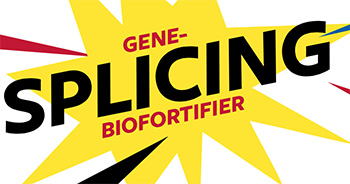
If you think plant breeding must be dull, you don't know Michael Gore.
Sure, the Cornell geneticist concerns himself with the traditional agricultural imperatives of higher yields and better resistance to drought and disease. But Gore's ambitions extend beyond the field. His aim is to make the human experience healthier, richer and more productive.
As a plant geneticist he places human interests at the center of the plant breeding process to create cultivars that contribute to solving nutritional and other problems faced by billions every day. Think maize packed with vitamins to counter childhood blindness, or nutrient-dense cassava to wipe out the worst symptoms of malnutrition. In Gore's world, a desert shrub becomes a potential source for domestic rubber, and industrial rapeseed a renewable jet fuel.
But it's his research into the biofortification of crops – staple foods packed with vitamins and micronutrients essential to human health – that most inspires his work.
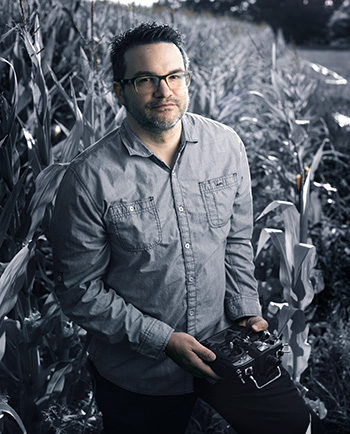
Michael Gore, associate professor of plant breeding and genetics. See larger image
"For individual human happiness to be achievable, a certain level of health is necessary. For too many, their food doesn't meet basic requirements," says Gore, associate professor of plant breeding and genetics in the College of Agriculture and Life Sciences. "Since the dawn of agriculture human ingenuity has shaped plants to be bigger, more robust. Now we are pushing science to improve the nutrition we get from our food in a way that will impact billions of lives for the better."
With a team of seven graduate students and five postdoctoral associates, Gore is pioneering quantitative genetic and genomic approaches to explore complex trait variations. Their work is revealing new insights into sustainable solutions to 21st-century problems.
"Cornell can attract some of the best minds in the world," Gore says of the students in his Bradfield Hall lab. Part of his team's work is developing the intelligence behind crop-sensing technologies that measure plant phenotypes instantaneously, accurately and at field-sized scales. In coming years the deployment of these high-throughput phenotyping technologies, allowing large-scale, rapid measurement of plant traits in little time, will be a reality. Drones in the sky and robots on the ground will use science he is pioneering to scan fields for disease and give growers early detection of emerging problems.
Gore envisions nutrition-focused plants and smart technology revolutionizing agriculture in the coming decades as scientists grapple with ways to feed a booming global population. For a plant breeder, that's anything but boring.
– Matt Hayes
Dr. Kristy Richards: Pack-leading oncologist
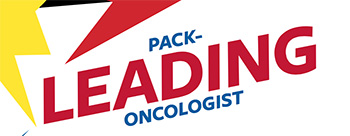
When Dr. Kristy Richards first told people she was looking at pet dogs as part of her cancer research, she'd get a lot of blank looks. "I'd tell my M.D. colleagues what I was doing, and they'd go, '… what?'" she says. Fortunately, the Cornell University College of Veterinary Medicine recognized a visionary when they saw one, recruiting Richards in 2015 to head up their nascent comparative cancer program. Now, Richards' research creates buzz rather than bafflement.
Richards, an oncologist, studies lymphoma, a common cancer in humans and the most common cancer in dogs. Her plan is to recruit canine lymphoma patients (pets, not research animals) to veterinary clinical trials to test potential treatments – and then, in collaboration with her colleagues at Weill Cornell Medicine, apply that knowledge in human lymphoma patients.
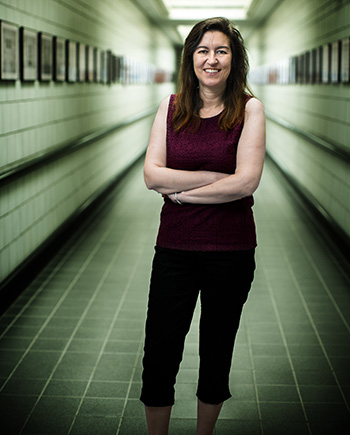
Dr. Kristy Richards, associate professor of biomedical sciences in the College of Veterinary Medicine. See larger image
Dog and human lymphoma patients share many biological similarities, as well as the unfortunate fact that rates of the disease are rising for both species. "We don't know why this is," Richards says. "It could be something in the environment, which both dogs and humans share. So in a way, dogs could be a canary in the coal mine."
Richards plans to test cutting-edge approaches such as immunotherapy, which harnesses the body's natural defenses to fight off cancer cells, in dogs suffering from lymphoma. This September, she was awarded a supplement grant from the National Cancer Institute, in partnership with the Roswell Park Cancer Institute in Buffalo, to further explore canine immunotherapy with veterinary patients that come to the Cornell University Hospital for Animals.
It's an exciting alternative to the current model for new drug development, which, for each new drug, takes an average of 15 years, costs $2.6 billion and has a mere 7 percent success rate. "We can't afford to spend this kind of time and money to test potential drugs," says Richards. "Veterinary trials are an untapped resource – we have a really powerful tool to advance these therapies much more rapidly and efficiently – plus, we can find cures for both dogs and humans at the same time."
In many ways, Richards and Cornell have been a match made in heaven. Richards was one of the only M.D.s in the country doing comparative oncology in dogs, which made her the perfect person to head the comparative cancer program. For Richards, Cornell's well-established reputation of excellence in lymphoma research made the admiration mutual. "When they asked me to come to bridge the gap between human and canine research, and work with all my favorite lymphoma people – I said of course. It's been a total win-win situation."
– Lauren Roberts
David Mimno: Big data-digitizing humanist
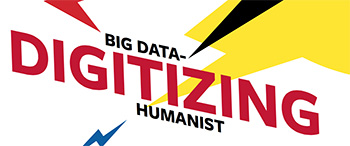
David Mimno, assistant professor of information science, is a prime example of the type of educator Ezra Cornell had in mind when he founded Cornell – one who combines fundamental knowledge with practical applications. In Mimno's case, this means a teacher who interweaves classics and the humanities with computers and data science to create collaborations that benefit both scholarship and students.
Mimno was interested in computational social sciences before he even knew the field existed. "I was always a history nerd and a computer geek," he recalls. "I realized I didn't have to choose. I could use my undergraduate classics major and combine it with a Ph.D. in computer science, and that was the toolkit I needed to most benefit scholarship."
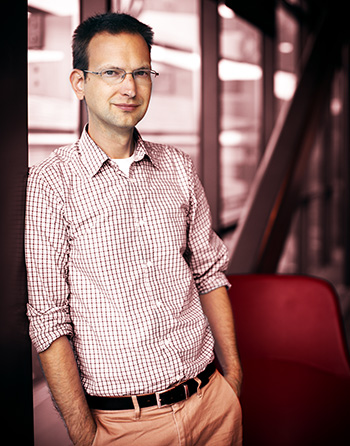
Assistant professor of information science. See larger image
He uses mathematical formulas to detect patterns in historical documents and literature and teaches the popular course Text Mining for History and Literature. "I like to contrast what people think is going to happen when you apply computers to literature [with] what really happens. A lot of the anxiety is that computers will miss the nuances of culture, but what actually happens is it's often the humans who will miss the subtle patterns as there is only so much their minds can memorize and process," he says.
Mimno is currently working with researchers at UCLA on reclassifying large volumes of Danish folktales. With the ability to digitize the 50,000 stories and count and classify the words, the researchers can take each story and compare it with similar stories and volumes. "We can reconstruct the ambiguity the original collector had in cataloging because we don't have the constraints he was facing," Mimno says.
"The study of culture, history and literature – everyone has a stake in [it]," says Mimno. "The same can be said of machine learning and data science. Algorithms affect us daily as we use social media, our nation's infrastructure and even our food supply. One of my motivations is showing how computation can benefit overall academic scholarship that helps find solutions for world problems."
Mimno was attracted to Cornell because of the friendly atmosphere and the ability to cross disciplinary boundaries. As a teacher, he most likes hearing from students that they are actually using things they worked on in class. "We have the monumental task of trying to train people to operate in a world that we fully expect they themselves will create," he says.
– Leslie Morris
James Grimmelmann: Pattern-detecting lawyer

Cornell Law School hired James Grimmelmann as a law professor, but they got a translator in the bargain. Grimmelmann, who started teaching at Cornell Tech this fall, is bridging the gap between students who dream of becoming "the Notorious R.B.G." (U.S. Supreme Court Associate Justice Ruth Bader Ginsburg '54) and those whose idols are more like Mark Zuckerberg. These students comprise the inaugural class of the new, one-year "law tech" Master of Laws program, which is designed to give already-practicing attorneys or recent law graduates the skills and knowledge to succeed in the technology and entrepreneurial ecosystem.
Grimmelmann studies the intersections between computers and the law, and what each side has to teach the other. A former Microsoft programmer, he's currently exploring ways of looking at copyright law through a computer science lens – in particular, figuring out how to quantify the expression in artistic work, and the similarities between different works. Grimmelmann says tech industry insiders already think about copyright this way: don't worry about defining aesthetics, just write some code.

James Grimmelmann, law professor. See larger image
"I think it would be very helpful for the legal system to understand how people who write software think about what they do," he says. "And this is a general principle for my work, which is that computer science is incredibly pragmatic. It's about getting computers to do things. And that pragmatic approach to deep questions sidesteps the philosophical issues and just says, 'What can we do?'"
Another facet of Grimmelmann's work involves teasing out an analogy between computer code and legal texts. "If you think about a statute that says 'don't speed,' it's like a computer program – it's a piece of text that does something in the world," he says.
"Even incredibly complicated programs can have completely determinate behavior. That possibility, of language that doesn't require controversial on-the-spot discretion, is a kind of a holy grail for lawmakers," Grimmelmann adds, noting this also raises the question of which features of the legal system can be delegated to machines. "Could you have automatic enforcement of rules against market manipulation that's simply an algorithm that spots suspicious trades and declares them illegal?" he asks.
Cornell Tech provides the perfect venue for someone wrestling with these liminal questions. "These are law students who are deeply interested in technology," Grimmelman says. "[There] are engineering students who are building things that are going to have massive policy implications. This is a really great moment for doing things that aren't held back by traditional boundaries."
Law students without a strong technical background shouldn't be intimidated, though – Grimmelman says they're already well equipped to get up to speed. "Lawyers learn new areas and new fact patterns all the time for cases," he says. "Learning tech is no different. It just requires the commitment to do it, and the humility to accept that you have to put in the work."
– Ian McGullam
Yimon Aye: Boundary-pushing chemist

Assistant professor of chemistry Yimon Aye's research begins with the 50 trillion or so cells contained in the human body. Every one of these cells is affected by highly diverse reactive chemicals, both good and bad, at any given time. How these different chemical signals and cells interact to maintain a healthy balance in the body has been a long-standing mystery – one Aye is determined to solve.
Her lab takes a unique, chemistry-driven approach to develop tools to study particular chemical-signaling events in the context of a single cell and of a whole organism. This approach started from "pure scratch," says Aye, and was unrelated to her previous research. "It was a high-risk, high-reward approach for a problem that is very important for the biological field. It will be a breakthrough if we can solve it."
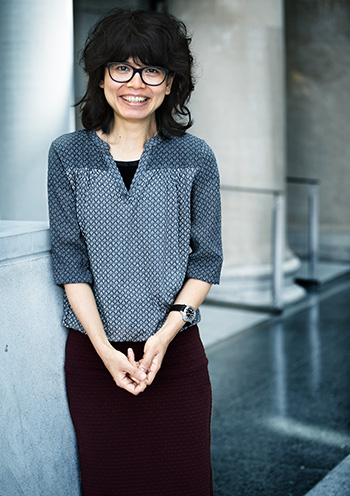
Assistant professor of chemistry Yimon Aye. See larger image
Aye, a Milstein Sesquicentennial Fellow in the College of Arts and Sciences, attributes her ability to tackle the complex biological research problems at the fundamental chemical level to her training in the cross-disciplinary fields of chemistry and biology and to the intellectual and scientific diversity at Cornell and at Weill Cornell Medicine, where she holds a secondary appointment. "The opportunities at the two campuses are incredibly unique," she says. "My lab has been able to take on new approaches, new ideas, new skill sets and new projects because of this collaborative environment."
She adds that biological faculty members at both Cornell and Weill Cornell Medicine "have always opened the door to help me with ideas, technique transfer and training opportunities – whatever would be beneficial to my students. They really care, not just about their own research but about how we can mentor students to prepare them for their future beyond Cornell."
The students and postdoc members in Aye's lab hail from seven countries, providing a diversity essential to doing good science, according to Aye. "It's very important when you try to solve a complex research problem to bring in different perspectives, different cultural and scientific ideas," she explains. "I personally favor thinking outside the box."
Aye notes the high quality of graduate students she has recruited. "They come to Cornell because of the level of knowledge and dedication and excitement here about science," she says. "At Cornell, they have the freedom to pursue their interests and what's most exciting for them. [They] can use the knowledge and expertise we have in our lab and also seek out other opportunities, like my grad student who reached out on his own to a professor in the vet school. I am very impressed with how passionate my students are."
– Linda B. Glaser